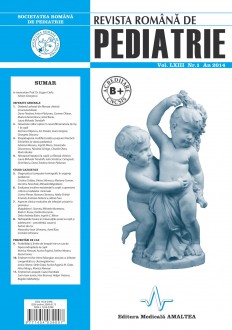SELECT ISSUE

Indexed

| |

|
|
|
| |
|
|
|

|
|
|
|
|
|
|
HIGHLIGHTS
National Awards “Science and Research”
NEW! RJP has announced the annually National Award for "Science and Research" for the best scientific articles published throughout the year in the official journal.
Read the Recommendations for the Conduct, Reporting, Editing, and Publication of Scholarly work in Medical Journals.
The published medical research literature is a global public good. Medical journal editors have a social responsibility to promote global health by publishing, whenever possible, research that furthers health worldwide.
CLINICAL ASPECTS AND EVOLUTION OF URINARY TRACT INFECTION IN PRETERM INFANTS
Magdalena I. Starcea, Mihaela Munteanu, Radu V. Russu, Ovidiu Brumariu, Delia Andreia Bizim and Ingrith C. Miron
ABSTRACT
Objective. The aim of the study is a comparative analysis of cases of UTI in children 0-3 years (preterm and term infants) admitted to the IVth Pediatric Clinic , “Sf. Maria” Emergency Hospital for Children, Iasi, between January 2007 – December 2011.
Material and methods. We performed a retrospective study on a group of 298 children, age 0-3 years, hospitalized with urinary tract infection (UTI). We identified the features of preterm infants with UTI according to the degree of prematurity, UTI etiology, comorbidities, developmental issues, responsiveness to treatment, and impact of UTI on kidney.
Results. The study group was divided into term and preterm children (defined as gestational age less than 37 weeks, weighing less than 2500g). Preterm UTI risk was influenced by age, being 3 times higher compared with children aged 1-3 years. The average age of UTI was 8.8 months for preterms and 14.09 months for term babies. Most preterm children were classified in LBW category. The etiology of urinary infection was dominated in both subgroups by E. coli, Proteus mirabilis and Klebsiella pneumoniae. In preterm children, opportunistic bacteria (bacillus Pseudomonas, enterococci, Acinetobacter) determined 16% of UTIs, compared to only 2% in term children. Fever was the dominant clinical sign in all patients. Other signs on preterms were loss of appetite, prolonged jaundice, diarrhea, respiratory distress. The onset of acute renal failure occurred in 12.5% of preterm and only 1% of term children. First line antibiotherapy was effective in most cases. In microbial resistance, the most frequently involved were aminopenicillins, Sulfamethoxazole-Trimethoprim and cephalosporins.
Conclusions. The early diagnosis and treatment have an important role in reducing infectious morbidity, the risk of renal scarring and rapid nutritional rehabilitation in preterm infants.
Keywords: urinary tract infection, preterm infant, CAKUT, E.coli
